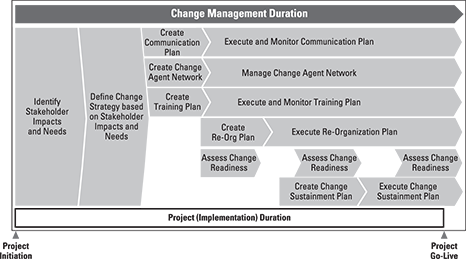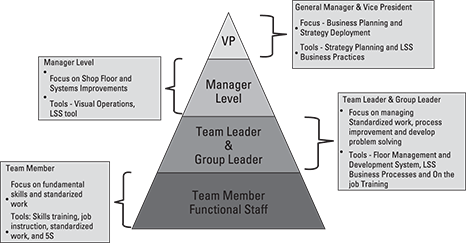Chapter 11
Creating the Right Culture
In This Chapter
![]() Understanding your organisation’s culture
Understanding your organisation’s culture
![]() Working through the cultural transformation process
Working through the cultural transformation process
![]() Getting stakeholders on board
Getting stakeholders on board
![]() Creating a vision of the desired company culture
Creating a vision of the desired company culture
![]() Developing leaders’ and employees’ skills
Developing leaders’ and employees’ skills
In order to achieve a Lean Six Sigma business transformation, you need to think about how the organisational culture should change for the new ways of working to be sustained. This chapter provides a pragmatic approach to planning a cultural change that will enable the business transformation to be both successful and sustained.
Culture, What Culture?
Every organisation has a unique culture, which will have developed over time. Culture can be simply described as the way people normally do things in an organisation and what they do when no one is around to tell them what to do. Employees and executives often take for granted the culture of their organisation, because they see and work with it every day. Individuals find it difficult to change their cultural mindset if they’ve worked for the same organisation for any length of time.
Cultures develop over time and are affected by:
- Events of the past
- The present climate
- The structure of the organisation
- Organisational aims
- The kind of people who work in the organisation
Understanding what culture means
To be able to design the Lean Six Sigma change programme and bring about the required changes in employee behaviour, you must first understand the culture of your organisation. MIT professor Edgar H. Schein proposes that culture has three components:
- Norms and values: These are what’s written on company literature, such as the mission statement, organisation charts, websites and business cards. These norms and values are then enacted in employee behaviours. However, some organisations do not practise what they preach and the enacted values may not align with those espoused.
- Underlying assumptions: These are the unwritten, unspoken things that happen within the organisation. They’re what people really pay attention to. Assumptions are difficult to tackle because they’re often subconsciously expressed and based on things that have happened in the past. For example, if a particular group of visitors comes to view an operation, could it mean that redundancies are in the offing? A Lean Six Sigma transformation programme will be derailed if people wrongly assume that lay-offs are about to occur.
- Artefacts and behaviours: These are anything that can be seen, felt or heard in the company. These artefacts and behaviours can be viewed as a cultural web, as shown in Figure 11-1.

Figure 11-1: The cultural web.
The cultural web can be broken down as follows:
- Symbols: Language and jargon demonstrating status.
- Power: Who has power within the organisation and whether their approach is autocratic or democratic.
- Structure: How the company is actually organised; for example, whether it’s tightly controlled or informal, hierarchical or organic.
- Systems: Whether the systems for maintaining control are focused on reward or punishment, and the number of such systems that exist.
- Routines and rituals: How established corporate behaviour is and how easy it is to introduce new ways of doing things.
- Stories and myths: Which members of staff are seen as heroes or villains and how these roles affect power and internal relationships.
Now that you recognise what organisational ‘culture’ entails, you can analyse that of your own company.
Assessing your organisation’s culture
You can choose from a number of methods to examine your organisation’s culture. For example, interviews and focus groups are powerful tools with which to gather first-hand information on how employees view the culture of their organisation, and to uncover possible resistance to change.
You can develop a set of questions based on the cultural web described in the preceding section. Think about the culture of your organisation and answer the following questions:
Symbols:
- What language and jargon are used within the organisation and on company literature?
- Are symbols readily accessible and understood both within and outside the organisation?
- What aspects of company strategy are highlighted in publicity material?
- What status symbols exist, such as company cars, business accounts or access to an executive dining room?
- Do particular symbols define the organisation?
Power:
- What core beliefs inform leadership?
- How strongly held are these beliefs (are those at the top idealists or pragmatists)?
- How is power distributed throughout the organisation?
- What are the main barriers to change?
Structure:
- Is the organisation structured along mechanistic or organic lines?
- Is the organisation structured hierarchically or horizontally?
- How formal or informal is the organisation?
- Does the company structure encourage collaboration or competition?
- What type of power balance does the organisational structure support?
Systems:
- What things are most closely monitored and controlled?
- Is emphasis on reward or punishment?
- Are controls related to past history or current strategies?
- Do many or few controls exist?
Routines and rituals:
- Which routines are emphasised?
- Which routines would look odd if changed?
- What behaviours do routines encourage?
- What are the key rituals?
- What core beliefs do these rituals reflect?
- What do training programmes emphasise?
- How easy is it to change routines and rituals?
Stories and myths:
- What core beliefs do company stories and myths reflect?
- How pervasive are these beliefs (at different levels throughout the organisation)?
- Do stories and myths relate to strengths or weaknesses; successes or failures; conformity or mavericks?
- Who are the heroes and villains?
- From which norms do the mavericks deviate?
Overall:
- What is the dominant culture?
- How easy will it be to change this culture?
A disadvantage of interviews and focus groups is that employees may not wish to openly express their views and opinions. If this is likely to be the case in your organisation, consider quantitative assessments instead. A quantitative assessment provides a snapshot of the organisation’s shared values and behaviours. A number of commercially available surveys can help you to capture data on employee satisfaction, employee engagement and organisational culture indicators, for example. Some surveys are available online; others may be administered by third parties. The great advantage of this survey method is that the anonymity and confidentiality it offers should attract more open and honest responses from employees.
Have a look at the following quantitative assessments:
- Creatrix (www.creatrix.com): This is a diagnostic tool focusing on innovation as the primary driver. It helps to build the innovative capacity of an individual/team or organisation.
- Business Improvement Review (www.rapidbi.com): The BIR is a strategic diagnostic tool that looks at culture, processes and capabilities.
- Organisational Culture Inventory™ (www.humansynergistics.com): The OCI provides organisations with a visual profile of their current operating culture in terms of the behaviours that members believe are required to ‘fit in’ and meet expectations.
Identifying the leadership culture
Effective leadership is one of the most important aspects of a successful Lean Six Sigma business transformation. The leadership style and behaviours that are prevalent in your company can have a huge impact on organisational performance and employee morale. Several cultural surveys are available to help you gather relevant data, including the Leadership Survey published by the Leadership Circle (see Figure 11-2). This survey enables you to carry out a thorough examination of your organisation’s leadership culture. The Leadership Survey:
- Establishes a compelling rationale to change leadership behaviour.
- Focuses leadership-development efforts.
- Identifies cultural challenges likely to be faced during a business transformation.
- Correlates leadership effectiveness to productivity, profits, turnover and other key metrics.

Figure 11-2: The Leadership Survey.
Initiating cultural change
To initiate a cultural transformation you need to consider which attitudes will have to shift, and how significant a change of viewpoint will be required from the average employee or manager.
What behaviours do we expect of the leaders involved in a Lean Six Sigma business transformation? Leaders must thoroughly understand what the organisation does, live the philosophy, and teach it to others. They need to support staff and the work they carry out, and take responsibility for the processes they operate.
Effective leaders must demonstrate the following key characteristics:
- Passion for Lean Six Sigma and its underlying principles and thinking
- Disciplined adherence to process accountability
- Project management orientation
- Ownership of the transformational change
- Balanced commitment to production and management systems
- Effective relationships with other business functions supporting the transformation programme
- Ability to measure processes and results separately
Leaders should also:
- Enjoy and respect people – help people feel good about themselves, see the good in each person and believe that everyone has something to contribute
- Think quickly and logically – be able to keep track of tasks and monitor the emotional climate of the group
- Be excellent communicators – be outstanding listeners, able to simplify themes, create clarity and engage and inspire people.
- Demonstrate warmth and inspire trust – convey warmth and friendliness, put people at ease and be non-judgemental
- Be goal orientated – focus on the end goal, ensure that decisions get made, push for tangible outcomes and be customer focused
The success of the business transformation process depends on the selection of good leaders. Employees will need role models and new heroes with whom to identify. Successful changes involve the creation of new myths built on heroic stories of the new ways of doing things.
Managing a Cultural Transformation
For the Lean Six Sigma transformation process to be successful, the culture of the organisation must change in order to embrace continuous improvement. Employees must feel empowered to make improvements to their business processes and work methods. To ensure that employees feel able to initiate improvements, you need to make sure that the organisational change process as a whole is effectively managed.
You need to be able to predict the issues and problems that must be addressed at each stage of the transformation in order to accelerate the change and minimise the pain. You also need to help people to let go of ingrained thinking and working and to embrace the new culture of continuous improvement.
Kotter’s eight steps to cultural change
Dr John Kotter’s eight-step process is a very effective method for managing cultural change. You will need to continuously repeat the process to sustain an effective cultural change as the Lean Six Sigma transformation is deployed over time.
The eight steps are discussed below:
- Establish a sense of urgency: You need to let stakeholders know why the Lean Six Sigma transformation must happen now and what the positive outcomes of immediate action will be – and the likely negative consequences of inaction.
- Form a powerful guiding coalition: You have to assemble a powerful group of people who are committed to achieving the transformation. This should include leadership team sponsors, employees who enjoy and thrive on change, and Lean Six Sigma practitioners who will assist teams in making process improvements.
- Create a vision: You must develop a future vision of the transformed organisation, linked to business strategy and the transformation plan (see the section ‘Utilising a cultural transformation plan’, later in this chapter).
- Communicate the vision: Make sure that you communicate regularly with all stakeholders throughout the Lean Six Sigma transformation journey.
- Empower others to act on the vision: You have to understand and remove unhelpful structures and systems to allow people to experiment and feel empowered.
- Plan for short-term wins: Ensure that you establish process improvements that create short-term benefits. Publicly reward people for their involvement in the improvements.
- Consolidate improvements and produce still more changes: Recognise and reward those able to promote and work towards the transformation vision. Sponsor new improvement projects to create a culture of continuous improvement.
- Institutionalise new approaches: Continue to reward people who exhibit empowered behaviours that lead to the achievement of the transformation objectives.
Lewin’s three phases of change
Another useful way of thinking about change is to use the three-stage theory of change commonly referred to as Unfreeze, Change, Refreeze, developed by Kurt Lewin and illustrated in Figure 11-3. The following sections describe these three stages in detail.

Figure 11-3: Lewin’s three phases of change.
Stage 1: Unfreeze
In today’s world of constant change, the unfreezing stage is probably the most important to understand. It is about getting ready to change. Unfreezing involves recognising that change is necessary and preparing to move away from your current comfort zone.
This first stage is about preparing employees for the change before the change takes place (and ideally creating a climate in which they actively want the change). The more people feel that change is necessary and urgent, the more motivated they are to make that change. If there’s no sense of urgency and people don’t understand why the change is needed, there’s no stimulus to make an immediate change and the need for change itself becomes less important.
Unfreezing and boosting motivation for the change involves weighing up the pros and cons and deciding if the pros outnumber the cons before any action is taken. Lewin calls this process Force Field Analysis. Force Field Analysis helps you to understand the different factors (forces) for and against making a change that you need to be aware of (analysis). If the factors for change outweigh the factors against it, you’ll make the change; if not, you won’t.
This unfreezing stage involves moving yourself, a department, or an entire business towards motivation for change. You may find it useful to create Force Field Analysis diagrams for each stakeholder group.
Stage 2: Change
In order to start the cultural change you need to change behaviours through a process called transition. Transition is the inner movement or journey that you make in reaction to a change. You need to help stakeholders to move towards a new way of working.
People often find transition a difficult process because they’re learning about upcoming changes and need to be given time to understand and work with them. It’s vital that you support your team during transition, by offering training or coaching, and expecting and accepting mistakes as part of the process.
Using role models and allowing people to develop their own solutions also makes the transition stage easier for your staff. Keep communicating a clear picture of the desired change and the expected benefits so that people don’t lose sight of where they’re heading.
Stage 3: Refreeze
This stage is about re-establishing stability once the changes have been made. The changes are accepted and become the new norm. People form new relationships and become comfortable with their routines. This stage can take time.
Lewin’s concept of refreezing is somewhat out of fashion. Instead, you need to see this final stage as being more flexible than a rigid frozen block. You must keep reviewing and reinforcing the cultural change to ensure that it’s accepted.
Utilising a cultural transformation plan
A cultural transformation plan will be invaluable in successfully managing the cultural change. The objectives and goals of the cultural transformation plan should be aligned to the Lean Six Sigma programme plan. The cultural transformation plan must be built around the steps of change discussed above and provide a detailed plan of how the cultural change will occur and be sustained. See the sample cultural transformation plan in Figure 11-4.

Figure 11-4: Sample cultural transformation plan.
The cultural transformation plan should include the following sections:
- Strategy and goals
- Stakeholders’ impacts and needs
- Organisational structure
- Communication plan
- Training plan
- Rewards and recognition plan
- Risk management plan
- Sustaining the change plan
Cultural transformation plans should be aligned with the phases of the Lean Six Sigma transformation programme to ensure that the organisation is prepared for the introduction of each phase. Plans should be regarded as living documents and actively updated to reflect changes in the programme. All plans should be communicated to stakeholders.
Achieving Stakeholder Buy-in
Getting stakeholders on-board with the cultural transformation is vital (refer to Chapter 2 for more on stakeholders). You need to identify change managers who can work with employees at all levels of the organisation to gain their buy-in.
The key change management roles and their functions are illustrated in Figure 11-5.

Figure 11-5: Change management roles.
Change managers need to build partnerships with all stakeholders – resistors and supporters, and those who are currently neutral. They must establish appropriate two-way communication with stakeholders and help them understand and agree to the cultural change that’s needed.
Acknowledging resistance to change
The change phase of the cultural change is often the hardest for people to cope with as they’re unsure of what’s involved. Although they may acknowledge that cultural change is necessary, people may still have concerns or feel resistant to it for some or all of the following reasons:
- Fear of the unknown – change involves ambiguity and uncertainty.
- Old habits and ways of doing things are unthreatening and comforting – cultural change is an unknown entity.
- Concern over loss of status, job security, money, authority, friendships and personal convenience.
- Selective perception that change is incompatible with the goals and interests of the organisation.
Failure to build effective partnerships with stakeholders has consequences. A lack of awareness of stakeholders’ concerns can eventually result in an unpleasant surprise – one you’re not prepared for. Unacknowledged resistance can explode at any time and ruin the transformation process. Perhaps more importantly, you also miss tapping in to those stakeholders who are your supporters and, as a result, lose their potential leverage.
Dealing with resistance
Resistance to change is natural – after all, the unknown may involve danger. Most people prefer to stick with what they know so don’t be surprised to encounter significant resistance. You need to uncover the source of such resistance so that you can take appropriate action.
Sources of resistance can be political, technical or cultural and can be expressed in the following ways:
Political:
- Will my department be made smaller?
- What makes them think they know how to run my department?
- Where’s my next career move?
Technical:
- Will it work?
- How will it work?
- I can’t see how it can save money.
Cultural:
- It’s against my principles.
- No one asked my opinion.
- It’s never been done like this before.
Stakeholders will be more ready to express organisational concerns than personal worries. Change agents thus need to develop supportive and open relationships with stakeholders so that they feel able to discuss their personal concerns regarding the anticipated change.
Developing the Vision for Change
The vision for change is a picture of your desired future, expressed in a way that resonates with all members of the organisation. The vision for change is shared with employees, customers, shareholders, vendors and candidates for employment, and creates shared meaning about what your organisation wants to look like – it becomes the rallying cry for the Lean Six Sigma transformation programme that seeks to capture hearts and minds.
You need to communicate the vision of the transformed business to all stakeholders in a way that is meaningful to them.
A change vision isn’t the same thing as a corporate vision. The change vision provides a view of what the organisation will be like after you’ve implemented cultural changes and worked through the Lean Six Sigma transformation process.
A great change vision is easy for people to understand, is only half a page long, communicates its message in 60 seconds, and is intellectually solid, but also has emotional appeal and speaks to the broad range of people who ultimately have to change, regardless of their status.
The first step in developing the vision is creating a statement on the future state of the organisation. This is most effectively achieved by using backwards visioning, which involves a team creating a picture of the future, by imagining that the change has been successfully completed. If this were the case, what would they expect to see, both internally and externally, in terms of things such as behaviours, measures, rewards and recognition?
You need to regularly review the cultural transformation vision to ensure that it reflects both changes made to the Lean Six Sigma transformation programme, and progress made. From time to time you need to re-energise people to ensure the momentum of the transformation journey is maintained.
Getting Communication Right
Throughout the transformation process you need to develop effective communication with all the stakeholders involved. Everyone in the organisation needs to be aware of the progress that’s being made, so a variety of communication channels must be developed.
Consider creating a communication network to reflect the involvement of key stakeholders, as shown in Figure 11-6.

Figure 11-6: Communication network.
Working out what to communicate and when
Measured proactive communication offers advantages over deferred or delayed communication. Secrets are hard to keep, so you need to be open, especially with positive messages.
Either way, an open approach is likely to reduce rumours and misconceptions, and should lead to people trusting their leaders. What’s more, steady and regular communications and updates help prepare people ahead of time and allow a gradual adjustment to the change.
Creating a communication plan
While communication planning is fairly straightforward in terms of the steps involved, the biggest challenge is often ensuring the plan can actually be delivered with the human and financial resources available to you.
The eight-step communication planning framework detailed here is designed for use by those who don’t have a communications background. To devise a workable plan, you need to work through the following eight steps in sequence:
- Set communication objectives.
- Establish key messages for your organisation.
- Define and prioritise key stakeholders.
- Establish additional key messages for each stakeholder group and their particular issues/concerns.
- Develop effective communication tactics for each stakeholder group.
- Allocate budgets and responsibilities.
- Develop a quarterly communications calendar.
- Assess results and adapt the plan.
Developing Employees’ Skills
Making people feel that they’re developing their skills is an important element in empowering them. Creating a learning culture within your organisation takes you one step beyond just acquiring the skills needed to deliver its products and services. It empowers your employees to achieve dramatically improved results compared to employees in more traditional organisations because they feel engaged. In turn, empowered employees more easily adapt to and anticipate change, which ultimately leads to an organisation that is more responsive to the marketplace and generates more energetic, loyal and goal-oriented employees.
Fostering a learning organisation
A learning organisation adheres to a set of attitudes, values and practices that support a process of continuous development. Training is a key element in the business strategy of an organisation dedicated to continuous learning. A true learning culture continuously challenges its own methods and ways of doing things. This ensures continuous improvement and the capacity to change.
Assessing learning needs
Providing new skills training for employees involved in the Lean Six Sigma transformation programme is a necessary element of the process. First you need to conduct a learning needs assessment and then you must develop a training and development plan. Appropriate training needs to be offered at each stage in the transformation process. The learning needs assessment identifies the required competencies and performance levels, assesses the gap between current knowledge/skill level, and plans training and education programmes. Figure 11-7 illustrates a typical approach to learning needs assessment.

Figure 11-7: Learning needs assessment.
Role-specific training
Role-specific training plans need to be developed because different roles focus on different aspects of work, and will therefore require different types of training (see Figure 11-8). For example, the senior management team focuses on strategic issues and so will require training and coaching in strategy deployment methods and tools. Managers will usually be involved with operations and will need to have training in Lean Six Sigma techniques including problem solving, visual management and managing daily improvements. Team members will need problem-solving skills and to be able to use specific Lean tools and standard work processes.

Figure 11-8: Role-based training.
To increase the overall capability of your organisation, staff training must be effective. Learning needs assessment must be aligned with organisational strategy, and training solutions must be deployed top-down to ensure leadership engagement.
Recognising that Change can be Rewarding
Everyone has a need to feel good about the work they do. Regularly rewarding and recognising your team members when they exhibit positive behaviours, rather than only noticing and commenting when they do something wrong, motivates them to keep up the good work and internalise the behaviour. You can let your staff know that they’ve done a good job in two ways:
- Offering informal recognition: This is the spontaneous pat on the back, warm word or sincere thank you that lets your employees know that you appreciate the job they’re doing. Such recognition takes no time, money or planning to execute.
- Setting up a formal reward programme: This is a pre-planned, firm-wide approach for rewarding individuals, departments and teams who achieve outstanding results. In general, implementing a formal reward programme involves time, money and a good deal of planning.
Various studies have shown that people thrive when they receive personal recognition for the work they do. While money is important, it will never replace the need for genuine appreciation for the efforts people put in. While everyone is expected to do their job well, recognition encourages and motivates staff to exceed those expectations.
Knowing when to reward
Studies have shown that regularly offering informal recognition to employees is a stronger motivator than providing formal rewards. Simple praise, perhaps a hand-written note, is remembered long after the event because it tells your employees that you noticed their efforts and took the time and trouble to personally thank them.
Although they don’t have the same everyday impact as informal recognition, formal rewards can become an important part of your strategy for service improvement. Quarterly and yearly award presentations should be highly publicised as part of your communications plan and send a clear message about the client service values and behaviours you hold in high esteem.
Initiating a reward and recognition plan
You need to include a reward and recognition plan that provides appropriate rewards at each stage of the change process. The backwards visioning exercise we discussed earlier in this chapter (in the section ‘Developing the Vision for Change’) may help you identify the behaviours you want to see either more or less of.
Before the cultural transformation begins, you need to identify the behaviours that should be rewarded and agree appropriate formal and informal rewards. As the journey then unfolds, stop rewarding those undesirable behaviours that you need to see less of.
Depending on the scale of the changes needed, the new behaviours may have to be implemented in steps. The achievement of each individual step must then also be recognised.
Giving Power to the People
Employees must feel a sense of ownership for their work and the processes that they’re involved in. Managers must create an environment that encourages employees to contribute to the Lean Six Sigma transformation.
Facing up to the management challenge
Good leaders show that they enjoy working with their staff and respect them; they recognise that everyone has something to contribute. They’re excellent communicators and outstanding listeners, simplifying themes and messages and bringing clarity to the goals and actions needed. Effective leaders keep track of progress and are aware of the emotional climate of the team.
If the leaders in your organisation don’t already possess these skills and attributes, they need to receive training. They need to be able to genuinely communicate with and understand key stakeholders – lip service won’t work.
Following the Lean Six Sigma approach
Leaders also need training on using Lean Six Sigma techniques and methods. In particular, they need to understand that their role is to work on the processes with the people in the processes to ensure they’re fully engaged and active participants in the transition to a culture of continuous improvement. They must walk the talk and live the key principles of Lean Six Sigma described in Chapter 1.
Giving power to teams
As part of the cultural transformation process management needs to introduce a new set of values and behaviours to remove existing barriers to employee empowerment.
If they’re to be involved and empowered, people need to feel a sense of:
- Competence – they’re learning from their experience and are gaining new skills and abilities.
- Significance – they’re contributing to and influencing the team’s performance.
- Community – they realise that they’re an integral part of a larger effort.
- Enjoyment – they have fun and enjoy their work.
Their active involvement in the daily team briefing is an essential element in securing their engagement.
Staying focused on the transformation process
The cultural transformation plan must be reviewed regularly and the culture of the organisation reassessed to ensure that it’s aligned with the ongoing transformation programme.

 Many change initiatives fail as the result of insufficient awareness of cultural factors – and that’s often the main reason why transformational change programmes fail to be sustained too.
Many change initiatives fail as the result of insufficient awareness of cultural factors – and that’s often the main reason why transformational change programmes fail to be sustained too. The John Lewis Partnership has a unique set of values expressed in its mission statement: ‘…a visionary and successful way of doing business, boldly putting the happiness of Partners at the centre of everything it does.’ This statement is the embodiment of an ideal, the outcome of nearly a century of endeavour to create a different sort of company, owned by Partners (its staff), and dedicated to serving customers with ‘flair and fairness’.
The John Lewis Partnership has a unique set of values expressed in its mission statement: ‘…a visionary and successful way of doing business, boldly putting the happiness of Partners at the centre of everything it does.’ This statement is the embodiment of an ideal, the outcome of nearly a century of endeavour to create a different sort of company, owned by Partners (its staff), and dedicated to serving customers with ‘flair and fairness’. To get a better understanding of the underlying assumptions operating within your organisation, listen to how other employees explain the culture to newcomers. What are the things that you must and mustn’t do?
To get a better understanding of the underlying assumptions operating within your organisation, listen to how other employees explain the culture to newcomers. What are the things that you must and mustn’t do? John Kenneth Galbraith’s Law of Human Nature states that: ‘Faced with the choice of changing one’s mind or proving that there is no need to do so, almost everybody gets busy on the proof.’ Rather than allowing stakeholders to develop entrenched resistance to the cultural change, you need to deal with their concerns promptly and honestly. Also bear in mind that resistance may be expressed at any stage of the transformation journey – not just at the start.
John Kenneth Galbraith’s Law of Human Nature states that: ‘Faced with the choice of changing one’s mind or proving that there is no need to do so, almost everybody gets busy on the proof.’ Rather than allowing stakeholders to develop entrenched resistance to the cultural change, you need to deal with their concerns promptly and honestly. Also bear in mind that resistance may be expressed at any stage of the transformation journey – not just at the start.